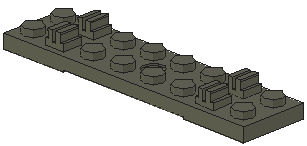Subject:
|
Re: The Future of Trains
|
Newsgroups:
|
lugnet.lego
|
Date:
|
Mon, 8 Oct 2007 21:03:16 GMT
|
Viewed:
|
22898 times
|
| |

|
|
In lugnet.lego, Benn Coifman wrote:
| |
I am sorry to hear the news, but I am not surprised. There are two things
Lego can do to help the transition on those of us with a large investment in
the 9v system.
1) the most consumable element in the 9v system is the train motor. But in
many cases I suspect it is the electric motor inside that burns out. And the
actual electric motor is likely a standard model produced by a third party
vendor. So provide us with information on the third party vendor and the
motor model so that we can crack open the lego case and replace the motor
unit when it burns out.
2) produce a single specialized lego element that would enable flex-track at
the right gauge. Like many of the other posters, originally, I had thought of
it being a tie or sleeper, similar to:

with the tabs being formed such that it would slip on one of the standard
stock of model rail available from hobby suppliers. It would allow us
unlimited straight and curve tracks, supporting the 9v line at the cost of
producing a single new part (no, I do not envision lego supplying the rail,
just that they make the clips compatible with something we could find on our
own). With all of the ballasting that clubs do, I suspect it would be
relatively easy to build up semi-permanent assemblies for shows.
Thinking further, if we were going to have a single part, it might be nicer
to have a 2x2 plate or tile with the clips, and thus, require a conventional
2x8 plate to connect it all together. The logic for 2x2 is that with
turntables, we might be able to cobble together complex switches using the
stock part. (Alternative sizes might be 1x2 aligned with the rail, 1x3
perpendicular to the rail, or 2x3 perpendicular to the rail)
Back at NMRA 2006, I walked around and spoke with a few of the model railroad
track manufacturers. All expressed hesitation to setting up new molds for a
new gauge (they would have to make all track geometries). I think it makes
more sense for the lego community to provide the sleepers, and the
conventional model community to provide the rail. Let each side do what it
does best. I think lego could more than break even on the part if sold for
$0.10ea (on the order of Ben Fleskes’s estimates). The profit margin on such
pieces might not be huge, but they will go far to keeping those customers
with a large investment in 9v trains happy and buying more lego. The parts
could even be used as detailing on non-train sets.
If the lego group does not want to pursue such specialized parts, they should
bring in the top third party producers (such as Ben Fleskes) and coordinate
so that the third parties can decide whether or not to proceed without fear
that a year later lego will come out with a similar part.
Benn
|
I did some research on this several years ago. At the time it was to pursue the
idea of wider radii curves. But now it’s of even more interest with the 9v track
going away.
I drew up several different ideas, and even contacted someone in a plastics
injection shop. Getting the price down on the indiviual ties is not a problem,
assuming a reasonable volume.
It’s the cost of the metal rail itself that’s an issue. Code 250 (1/4” tall)
nickle silver rail is ~$2.60 a linear foot at retail prices. That comes out to
a little over $2 for the rail needed in a single 16 stud long section of track.
This could be reduced I’m sure by buying in a large enough quanity, but not
much. Or by going to aluminum, it’s ~$.50 a foot, but that material isn’t ideal.
Aluminum builds up a nasty oxide, and can’t be solderd.
Atlas uses a code 240 NS rail for thier O-gauge track system. Based on thier
reatil price for track, the rail would be afforadable if it could be pruchased
seperatly.
Then there’s the cost/effort of bending and cutting the rails the the correct
size and length. And designing and building switches is an even greater task.
Plastic tie, single:
http://www.brickshelf.com/cgi-bin/gallery.cgi?i=2758909
Plastic Tie, double:
http://www.brickshelf.com/cgi-bin/gallery.cgi?i=2758910
|
|
Message is in Reply To:
 | | Re: The Future of Trains
|
| (...) I am sorry to hear the news, but I am not surprised. There are two things Lego can do to help the transition on those of us with a large investment in the 9v system. 1) the most consumable element in the 9v system is the train motor. But in (...) (17 years ago, 7-Oct-07, to lugnet.lego, FTX)
|
124 Messages in This Thread:
(Inline display suppressed due to large size. Click Dots below to view.)
- Entire Thread on One Page:
- Nested:
All | Brief | Compact | Dots
Linear:
All | Brief | Compact
|
|
|
|